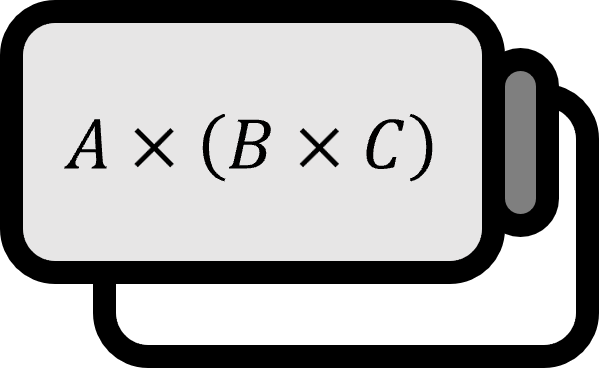Curved Coordinate Systems: Coordinate Transformations and Jacobians
Formulas
The volume in a 3-dimensional Cartesian coordinate system is represented for any curvilinear coordinate system as follows.
$$ dxdydz =\begin{vmatrix} \dfrac{ \partial x}{ \partial q_{1}} & \dfrac{ \partial y}{ \partial q_{1}} & \dfrac{ \partial z}{ \partial q_{1} } \\[1em] \dfrac{ \partial x}{ \partial q_{2}} & \dfrac{ \partial y}{ \partial q_{2}} & \dfrac{ \partial z}{ \partial q_{2} } \\[1em] \dfrac{ \partial x}{ \partial q_{3}} & \dfrac{ \partial y}{ \partial q_{3}} & \dfrac{ \partial z}{ \partial q_{3} } \end{vmatrix} dq_{1}dq_{2}dq_{3} = \begin{vmatrix}\dfrac{ \partial x}{ \partial q_{1}} & \dfrac{ \partial x}{ \partial q_{2}} & \dfrac{ \partial x}{ \partial q_{3}} \\[1em] \dfrac{ \partial y}{ \partial q_{1}} & \dfrac{ \partial y}{ \partial q_{2}} & \dfrac{ \partial y}{ \partial q_{3}} \\[1em] \dfrac{ \partial z}{ \partial q_{1}} & \dfrac{ \partial z}{ \partial q_{2}} & \dfrac{ \partial z}{ \partial q_{3}} \end{vmatrix}dq_{1}dq_{2}dq_{3} $$
Here, the determinant represented as a coefficient is called the Jacobian and is denoted as $J$. The Jacobian of each coordinate system is as follows.
Polar coordinate system:
$$ J_{polar}=\begin{vmatrix}\dfrac{ \partial x}{ \partial r} & \dfrac{ \partial x}{ \partial \theta} \\[1em] \dfrac{ \partial y}{ \partial r} & \dfrac{ \partial y}{ \partial \theta} \end{vmatrix}=r $$
Cylindrical coordinate system:
$$ J_{cylinderical}= \begin{vmatrix}\dfrac{ \partial x}{ \partial \rho} & \dfrac{ \partial x}{ \partial \phi} & \dfrac{ \partial x}{ \partial z} \\[1em] \dfrac{ \partial y}{ \partial \rho} & \dfrac{ \partial y}{ \partial \phi} & \dfrac{ \partial y}{ \partial z} \\[1em] \dfrac{ \partial z}{ \partial \rho} & \dfrac{ \partial z}{ \partial \phi} & \dfrac{ \partial z}{ \partial z} \end{vmatrix}=\rho $$
Spherical coordinate system:
$$ J_{spherical}=\begin{vmatrix}\dfrac{ \partial x}{ \partial r} & \dfrac{ \partial x}{ \partial \theta} & \dfrac{ \partial x}{ \partial \phi} \\[1em] \dfrac{ \partial y}{ \partial r} & \dfrac{ \partial y}{ \partial \theta} & \dfrac{ \partial y}{ \partial \phi} \\[1em] \dfrac{ \partial z}{ \partial r} & \dfrac{ \partial z}{ \partial \theta} & \dfrac{ \partial z}{ \partial \phi} \end{vmatrix}=r^{2}\sin\theta $$
Proof
As shown above, when the position vector $\mathbf{r}$ changes, the volume of the resulting parallelepiped is as follows.
$$ d\mathbf{r}_{x} \cdot (d\mathbf{r}_{y} \times d\mathbf{r}_{z})=dxdydz $$
In the curvilinear coordinate system, let us say the change in the position vector $\mathbf{r}$ when $d\mathbf{r}_{i}$ changes to $i$ component by $dq_{i}$.
$$ d\mathbf{r}=d\mathbf{r}_{1}+d\mathbf{r}_{2}+d\mathbf{r}_{3} $$
Then, the volume of the parallelepiped formed by $d\mathbf{r}$ remains unchanged, whether represented in Cartesian coordinates or any curvilinear coordinate system. In other words, the value of $d\mathbf{r}_{1}\cdot (d\mathbf{r}_{2}\times d\mathbf{r}_{3})$ remains constant regardless of the coordinate system, only the variables represent it change. If $dq_{i}$ is a very small change, then it can be approximated as follows.
$$ \begin{align*} d\mathbf{r}_{1} &= \mathbf{r}(q_{1}+dq_{1},q_{2},q_{3})-\mathbf{r}(q_{1},q_{2},q_{3}) \\[1em] &=\dfrac{ \mathbf{r}(q_{1}+dq_{1},q_{2},q_{3})-\mathbf{r}(q_{1},q_{2},q_{3})}{ d q_{1} }dq_{1} \\[1em] &= \dfrac{ \partial \mathbf{r}}{ \partial q_{1} }dq_{1}=\left( \dfrac{ \partial x}{ \partial q_{1}}\hat{\mathbf{x}}+\dfrac{ \partial y}{ \partial q_{1}}\hat{\mathbf{y}}+\dfrac{ \partial z}{ \partial q_{1} }\hat{\mathbf{z}} \right)dq_{1} \\[1em] d\mathbf{r}_{2} &= \dfrac{ \partial \mathbf{r}}{ \partial q_{2} }dq_{2}=\left( \dfrac{ \partial x}{ \partial q_{2}}\hat{\mathbf{x}}+\dfrac{ \partial y}{ \partial q_{2}}\hat{\mathbf{y}}+\dfrac{ \partial z}{ \partial q_{2} }\hat{\mathbf{z}} \right)dq_{2} \\[1em] d\mathbf{r}_{3} &= \dfrac{ \partial \mathbf{r}}{ \partial q_{3}}dq_{3}=\left( \dfrac{ \partial x}{ \partial q_{3}}\hat{\mathbf{x}}+\dfrac{ \partial y}{ \partial q_{3}}\hat{\mathbf{y}}+\dfrac{ \partial z}{ \partial q_{3} }\hat{\mathbf{z}} \right)dq_{3} \end{align*} $$
Therefore, the volume is calculated as follows.
$$ \begin{align*} d\mathbf{r}_{1} \cdot (d\mathbf{r}_{2}\times d\mathbf{r}_{3}) &= \left( \dfrac{ \partial \mathbf{r}}{ \partial q_{1}}dq_{1} \right)\cdot \left( \dfrac{ \partial \mathbf{r}}{ \partial q_{2}}dq_{2}\times \dfrac{ \partial \mathbf{r}}{ \partial q_{3}}dq_{3}\right) \\[1em] &= \left( \dfrac{ \partial \mathbf{r}}{ \partial q_{1}} \right)\cdot \left( \dfrac{ \partial \mathbf{r}}{ \partial q_{2}}\times \dfrac{ \partial \mathbf{r}}{ \partial q_{3}}\right)dq_{1}dq_{2}dq_{3} \\[1em] &= \begin{vmatrix} \dfrac{ \partial x}{ \partial q_{1}} & \dfrac{ \partial y}{ \partial q_{1}} & \dfrac{ \partial z}{ \partial q_{1} } \\[1em] \dfrac{ \partial x}{ \partial q_{2}} & \dfrac{ \partial y}{ \partial q_{2}} & \dfrac{ \partial z}{ \partial q_{2} } \\[1em] \dfrac{ \partial x}{ \partial q_{3}} & \dfrac{ \partial y}{ \partial q_{3}} & \dfrac{ \partial z}{ \partial q_{3} } \end{vmatrix} dq_{1}dq_{2}dq_{3} \end{align*} $$
For any matrix $A$, since $\left| A^{T} \right| =\left| A \right|$, the following is obtained.
$$ \begin{align*} dxdydz &=\begin{vmatrix} \dfrac{ \partial x}{ \partial q_{1}} & \dfrac{ \partial y}{ \partial q_{1}} & \dfrac{ \partial z}{ \partial q_{1} } \\[1em] \dfrac{ \partial x}{ \partial q_{2}} & \dfrac{ \partial y}{ \partial q_{2}} & \dfrac{ \partial z}{ \partial q_{2} } \\[1em] \dfrac{ \partial x}{ \partial q_{3}} & \dfrac{ \partial y}{ \partial q_{3}} & \dfrac{ \partial z}{ \partial q_{3} } \end{vmatrix} dq_{1}dq_{2}dq_{3} \\[1em] &= \begin{vmatrix}\dfrac{ \partial x}{ \partial q_{1}} & \dfrac{ \partial x}{ \partial q_{2}} & \dfrac{ \partial x}{ \partial q_{3}} \\[1em] \dfrac{ \partial y}{ \partial q_{1}} & \dfrac{ \partial y}{ \partial q_{2}} & \dfrac{ \partial y}{ \partial q_{3}} \\[1em] \dfrac{ \partial z}{ \partial q_{1}} & \dfrac{ \partial z}{ \partial q_{2}} & \dfrac{ \partial z}{ \partial q_{3}} \end{vmatrix}dq_{1}dq_{2}dq_{3} \end{align*} $$
■
